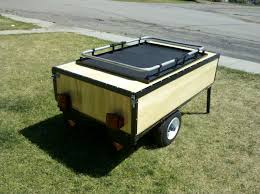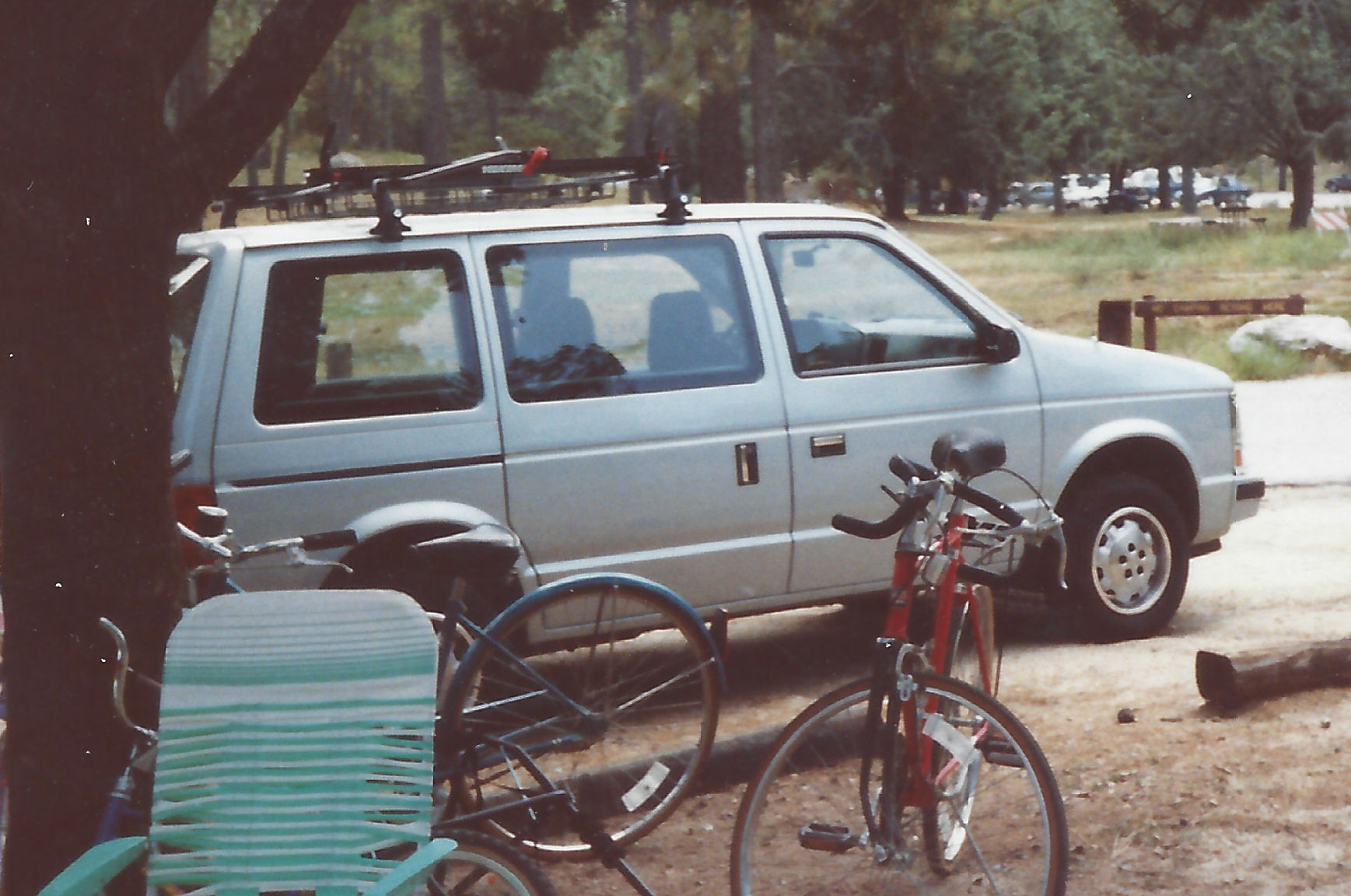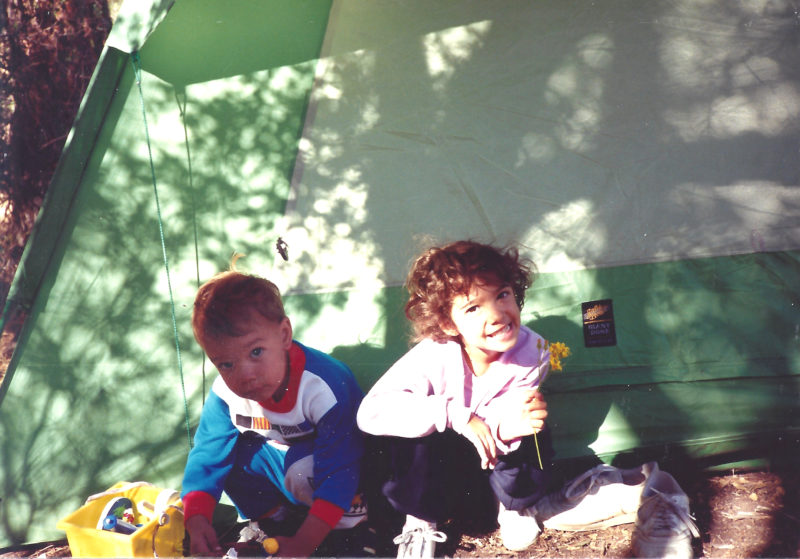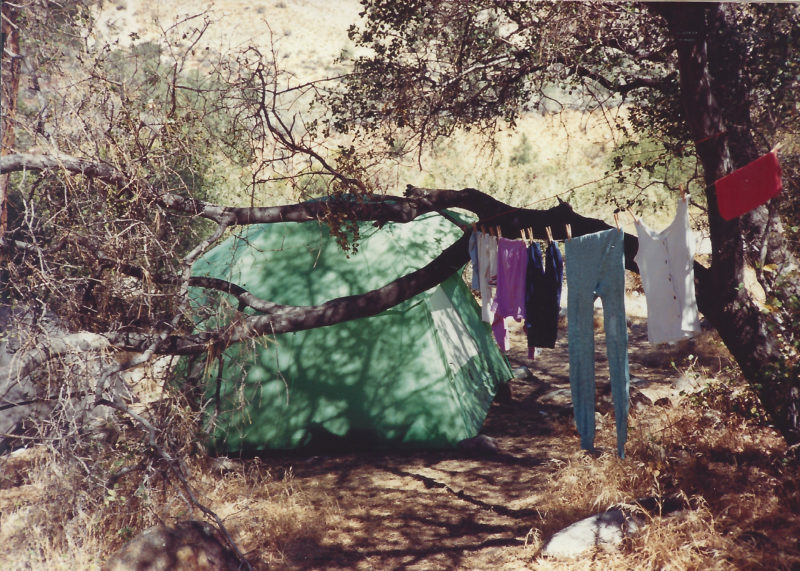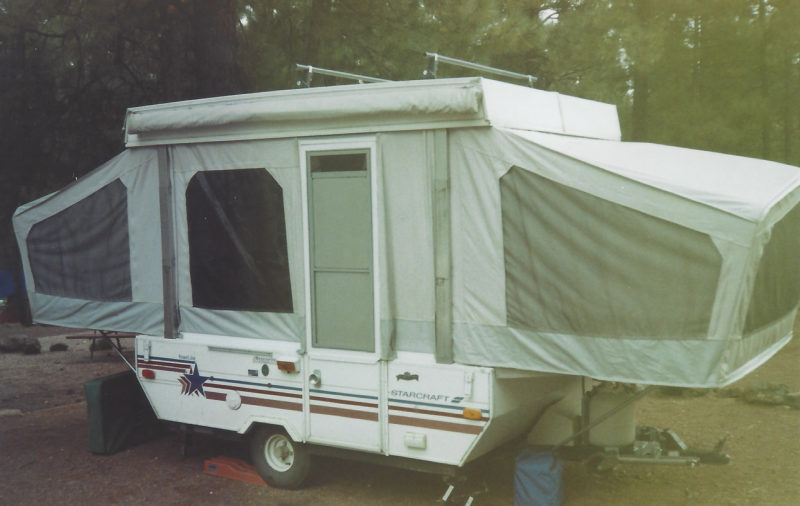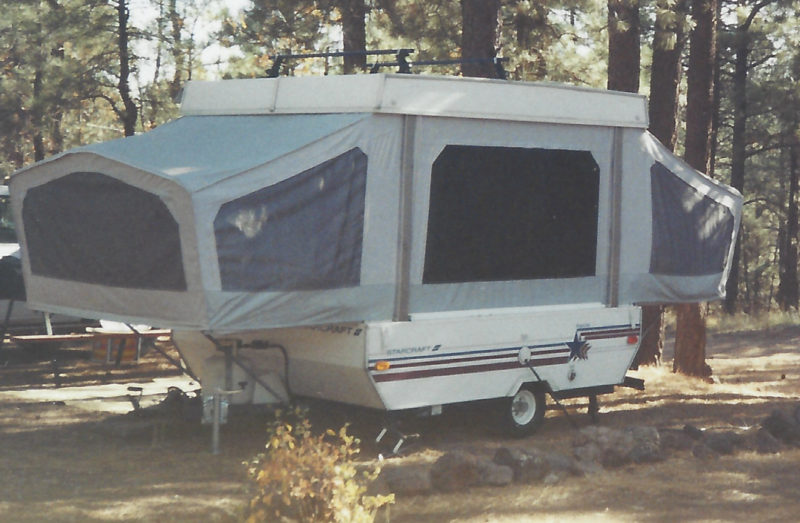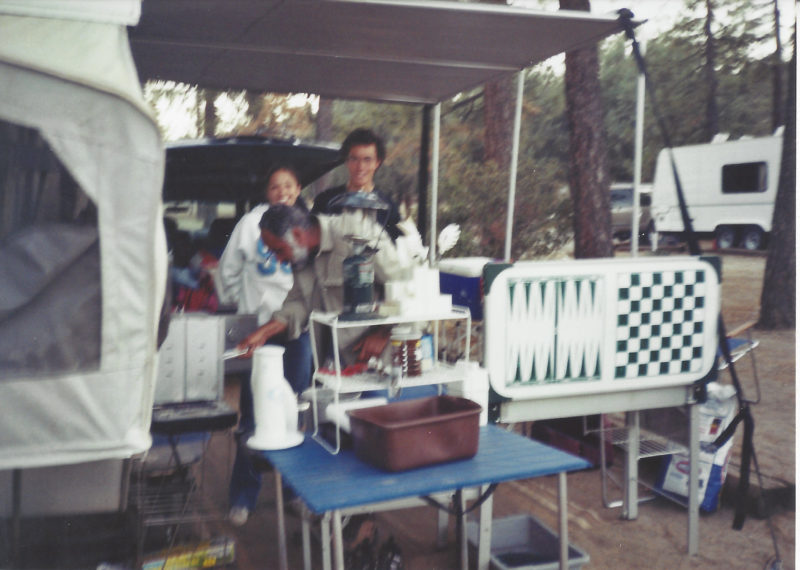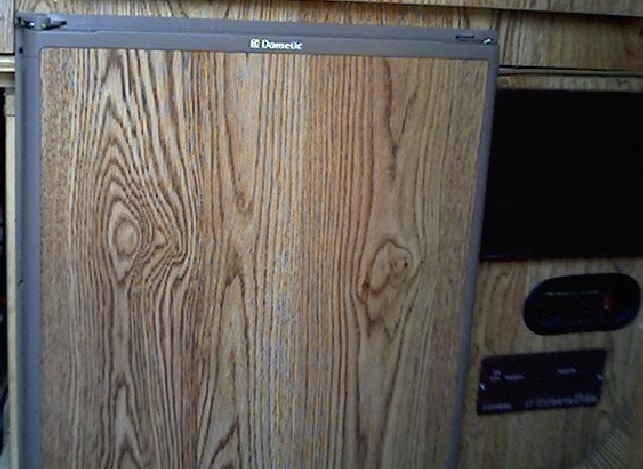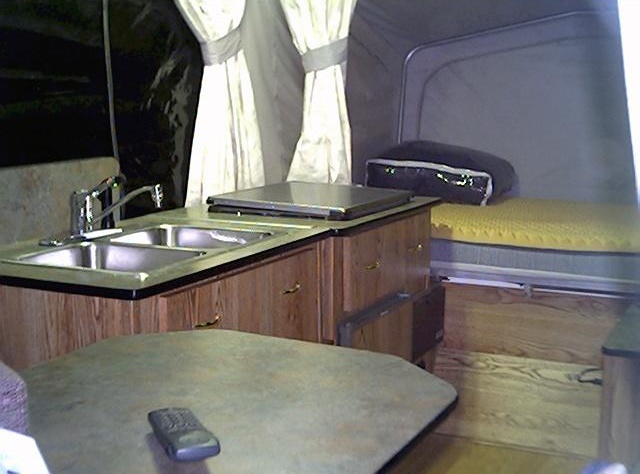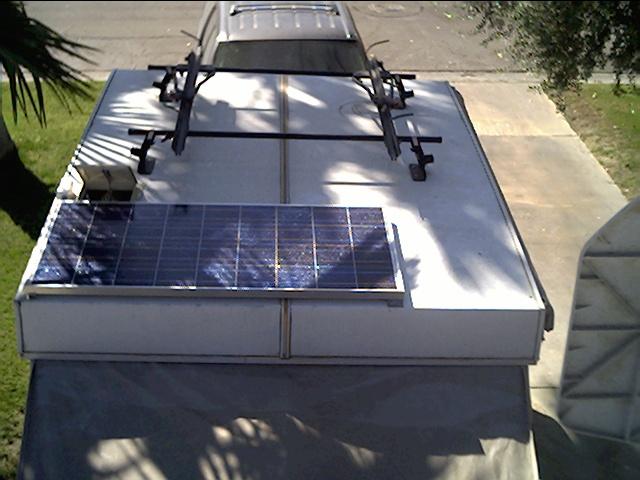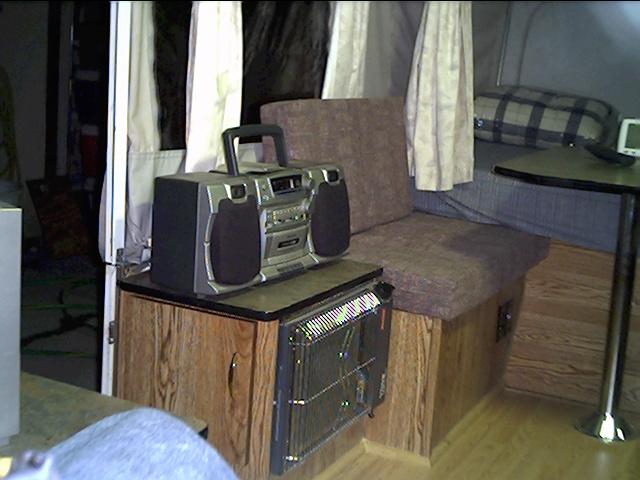What the title of this post means is to figure out what you want and need in a camper before you purchase your first one, because most people find out that after they purchase that first camper, it doesn’t do what they want it to do. At this point, seeing the deficiencies of that first camper, they buy a second camper that better fits their style of camping.
So I thought I’d share my experiences over the years with 4 different campers, what I now look for in a camper, and how my needs changed over time. Now, I’m not presenting my thoughts as some sort of a subject matter expert. My thoughts are based on semi-quasi science, that can be summed up in this statement, that I read somewhere years ago.
If you learn from your mistakes I must be a genius.
Timeout Motorcycle Trailer
My first camper was a small tent trailer that was towed behind a 1977 Honda CB750K motorcycle. Back in the 70’s a motorcycle towable camper was a rarity and Timeout was just about the only brand available. At the time I wanted to do a 3 month, 10,000 mile coast to coast trip that would include exploring parts of Canada. I knew my first wife wouldn’t go for a trip like this if she had to sleep on the ground in a tent.
I got really lucky. A guy in Palm Springs, who was 76 and felt he was getting to old to ride, had one for sale and it was nearly new. He didn’t want a lot of money, just wanted a fellow motorcyclist to enjoy it. It was a bargain for only $500.
It really was a small cargo trailer whose roof and one side could be folded out to become part of the floor. A tent was erected on the platform. In essence it was a platform on wheels that kept the tent off the ground. There wasn’t much storage inside when folded up for travel, as the canvas tent took up most of the space. The top had a cargo rack and could store a cooler and a few other items. When the trailer was opened up to be converted into a tent, the cargo rack was removed and positioned to be the frame supporting the folded out top and side.
That trailer looked similar to this one except our had shinny new looking aluminum sides and top:
To give credit to the owner of the pictures above, I found them on this website.
For very minimal functionality, and most importantly lightweight and compact length and width, the Timeout was absolutely wonderful. The coupler on the trailer’s tongue was unique and could only connect to the special hitch designed for motorcycles. In just a few minutes I could remove the coupler from the trailer and replace it with a standard one that could be attached to the typical drawbar and ball used on most trailer hitches. Sometimes we would tow it behind our 2-door Chevrolet Monte Carlo.
Then the kids arrived. Two toddlers strapped into car seats in the back of the Monte Carlo. Instead of the bulky canvas tent that was integral to the Timeout Trailer, I bought a nylon car camping tent and the trailer became a cargo trailer that carried most of our gear.
Times change, kids started growing, and we purchased the vehicle that is dreaded by most image conscious men today – the ubiquitous mini-van. Ours was one of the first mini-vans produced, a 4 cylinder 1988 Dodge Caravan SE. This was the basic model that cost us around $10,000 new.
Car/tent camping with kids is somewhat of a hassle, too much time organizing gear, equipment, and all the other things that are a part of the camping experience. Not to mention the fact we often camped for 1-2 weeks at a time.
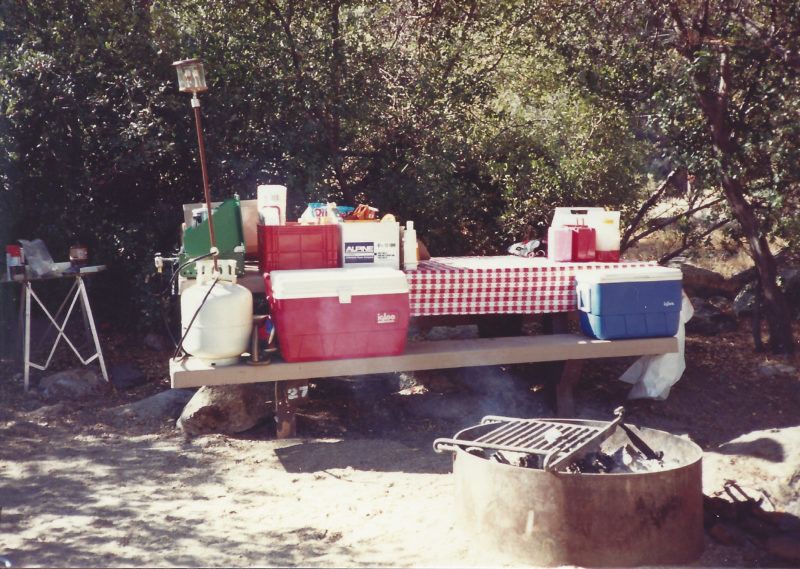

It was time to upgrade.
1992 Starcraft Meteorite
We didn’t do much shopping around for this camper. Our Dodge Caravan couldn’t tow much. 1,500 lbs max. So our choices were limited to the lightest campers. This was my introduction to How Much Trailer Can You Tow? There were almost no amenities in the Meteorite and it weighed around 900 lbs. fully empty. No battery, no interior lights, no heater until I bought a Wave heater. No water heater. It had a 5 gallon water tank, and a sink faucet you had to pump to draw water – so it was next to useless. I took the sink out for more room, and we did dishes outside with one of those fold-up camp kitchens. No refrigerator, but an ice box that looked like a refrigerator and whose only useable function was a place to store bread, hamburger and hot dog buns, and potato chips. The stove was okay, as it could be moved outside for use or used indoors.
But it was a wonderful camper for a family of four. We camped in it a lot, usually for 1 to 2 weeks at a time in US Forest Service Campgrounds. We were off the ground and could eat inside it when it rained or were under siege by such things as mosquitoes or bees. Nothing needed upgrading. Time saving modifications and other things that camper owners do were not required, because that’s why one should have children, so they can do the camping chores 🙂
However there was still a lot of packing and unpacking of gear and equipment. The camper was so small there was little storage space.
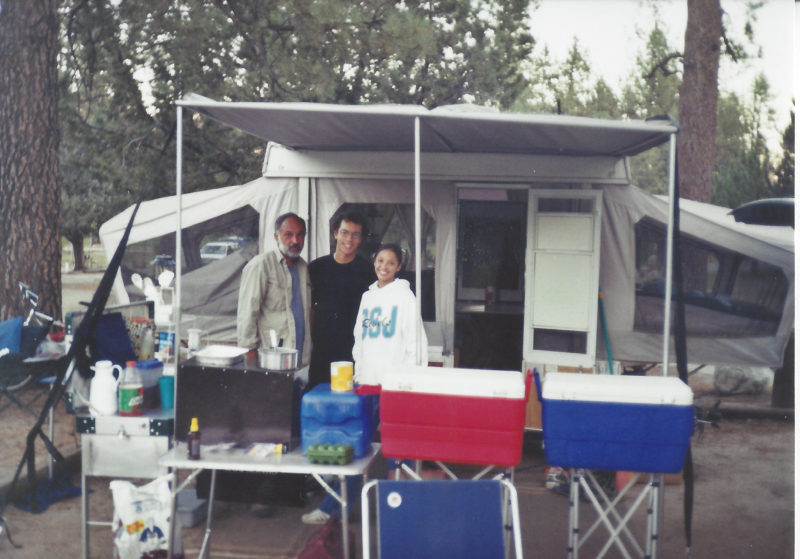
Times Change, Life Changes & Needs Change
By 2002 I was divorced and remarried. My new wife, Joyce, had never been camping. We did a few trips with the camper and she loved it. Things were a little primitive such as boiling water to wash dishes, but we were having so much fun together we started camping nearly every weekend and on vacations. The amount of equipment that had to be loaded and unloaded from our SUV became time consuming and inefficient. The Meteorite was basically a tent with a lot of wasted space, so instead of buying a new camper, I decided to gut the interior and redesign it, with any eye to installing all the amenities that a larger camper would have. I probably spent more time researching, drawing and revising plans than the time it took to complete the work. The design stage was an exercise of determining what we would need in a camper based on my 25 years of tent trailer use and Joyce’s unbiased input as a new camper. The challenge was to design a well-functioning camper with minimal space. Were we up to the challenge? Given the results, yes we were! I started with a list of our desired features and amenities. The list could function as a Checklist to assist someone who is looking to buy their 2nd camper the 1st time.
Limiting Factors
A tent trailer is just a box. The beds slide out and the box is your living area. Our box was one of the smallest on the market, 8 feet long and 7 feet wide. This gave us 56 square feet of living space to work with, not taking into the consideration that the front and rear ends were sloped, reducing the area at the floor even more.
Another problem was adding equipment would raise the weight of the trailer beyond the manufacturer’s specifications. However I found a solution for that too.
List of 15 Desired Features and Amenities
1. Increase Weight Carrying Capacity

We couldn’t safely add much stuff. The limitation was our tires. The axle was rated for 2,200 lbs. and frame even more, but the tires much, much less – only 1,180 lbs. It needed larger tires, but larger tires wouldn’t fit. So we had to lift the body higher on the axle with special plates I had fabricated and then we bought much larger tires with a load carrying capacity to match the axle and frame, which also required buying larger rims, hubs, bearings, and seals. Our new tires had a load carrying capacity of 2,500 lbs.
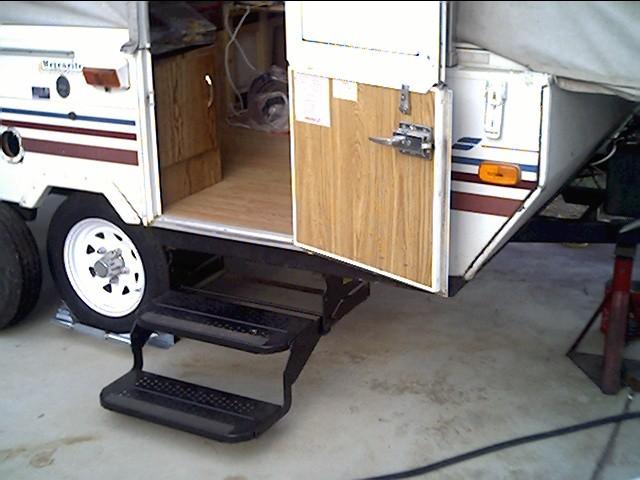
2. Refrigerator
The camper came with a silly ice box with a door that opened like a refrigerator. It couldn’t keep anything cold unless there was a huge block of ice in it that took up most of the space. Since we rarely camp where there is electricity, we purchased a small 1.9 cubic foot 3-way refrigerator that ran on propane, 120 volts or 12 volts. It worked great on propane and running 12 volts would quickly kill a battery, but it was a lifesaver to run it on 12 volts when towing because the propane flame would blow out when traveling and the tow vehicle’s alternator kept the battery fully charged.
3. Three Burner Stove
The camper came with a two burner indoor/outdoor stove. It worked well, but the burners, like all two burner camping stoves, were too close together. Three burner stoves allow you to use full size kitchen pots and pans.
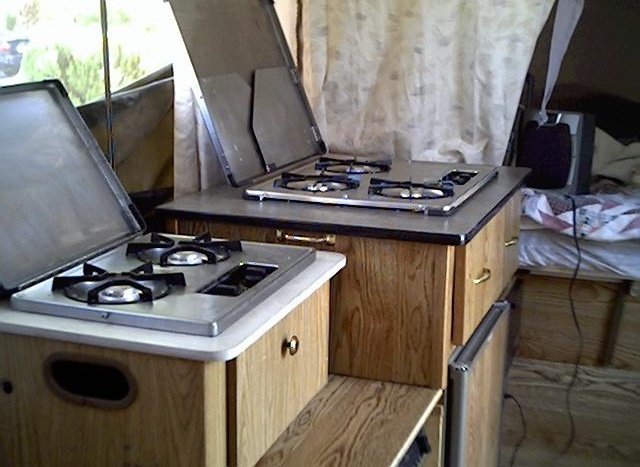
4. Double sink
The camper originally came with a single sink and a hand pump faucet that drew water from a portable 5 gallon tank; meaning there was no hot water to wash with. I need two sinks to wash dishes. The pump handle was a pain in the butt, and the 5 gallon potable tank was too small.
5. Kitchen Faucet
We also wanted a regular kitchen faucet with a cold and hot control. A regular faucet would require an electric water pump.
6. Electric Water Pump (12 volt)
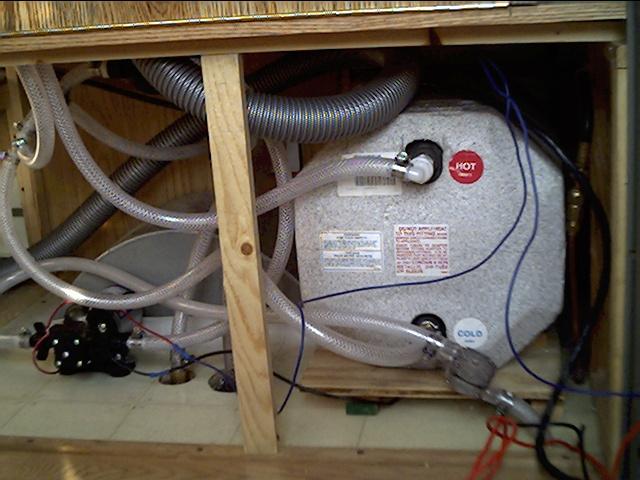
This is self-explanatory. A regular water faucet would need a pump.
7. Larger Fresh Water Tank
The original portable water tank was stored inside, further reducing usable storage space. So an external tank mounted under the body was the only real option. I ended up installing a 14 gallon tank under the body and over the axle so minimize the effect 116 pounds of water would have on tongue weight. The 14 gallon tank was the largest I could fit in the desired location.
8. Water Heater

A water heater would allow for washing dishes without boiling water. Plus at 6 gallons capacity it adds 6 gallons to our water storage. We would now have a total of 20 gallons of hot and cold water capacity.
9. Interior Shower
As long as we had hot and cold water, we might as well build a shower inside. This was the most difficult stage of the design; how would we build it and how would we utilize space. The solution was to build it under one of the dinette seats and it worked well. Many people have copied our design.
10. Battery Bank
The camper came with space on the tongue for a small 12 volt battery. I had never bothered to install one, because the only thing it would power was the single ceiling light, which wouldn’t provide much light anyway. But with the water pump, we would need a battery. Plus with a battery, we could install outlets and an inverter to power small appliances, such as a portable fan and a blender to make blended ice cold Margaritas. We ended up installing two group 27 RV batteries.
11. Solar System
Camping for extended periods requires a method to keep the batteries charged. Since we were usually camping without access to the power grid, and I hated noisy generators, the only option was solar. Back in 2003 few people were using solar for RV’s and much time was needed to get an education. Plus there was the challenge of installing solar panels on the roof of a tent trailer, because the roof is raised during set-up and lowered for traveling and the wiring must accommodate this. Those obstacles were solved during planning.
12. Heater or Furnace
RV furnaces take up a lot of room, and they use a lot of electricity and propane. So we opted for a flush mounted Wave 6 Catalytic heater that requires no electricity and uses 75% less propane than a furnace.
13. Dual Propane Tanks
The camper came with hardware for a single 5 gallon propane tank. Given our long winter trips with temps around freezing we wanted more propane capacity. It was easy to mount new hardware.
14. An Easy to Use Awning
The camper came with the least expensive (and awful) bag awning. We replaced it with a Fiamma F35 awning.
15. Rooftop Air Conditioner
This was part of our original plan, but was done soon after the other work. About the only time we camped with hook-ups was at the Colorado River so we could play in the river with our inflatable raft. And as we were getting older, camping in 120F weather without A/C was getting old. So we installed a regular rooftop A/C.
Re-Build & Installation
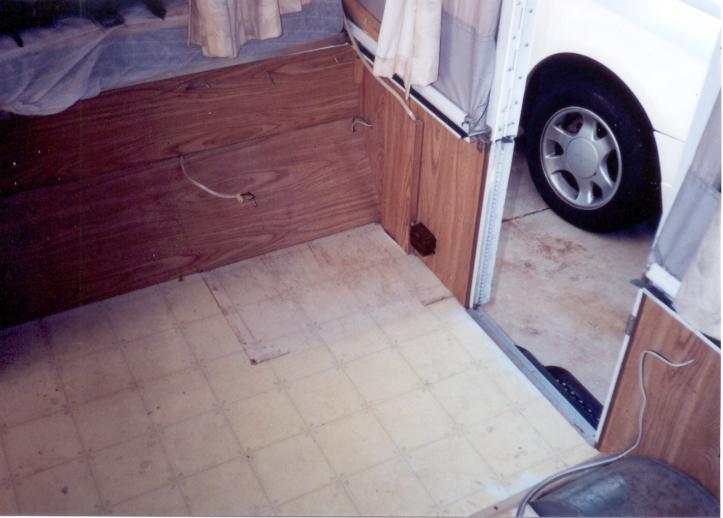
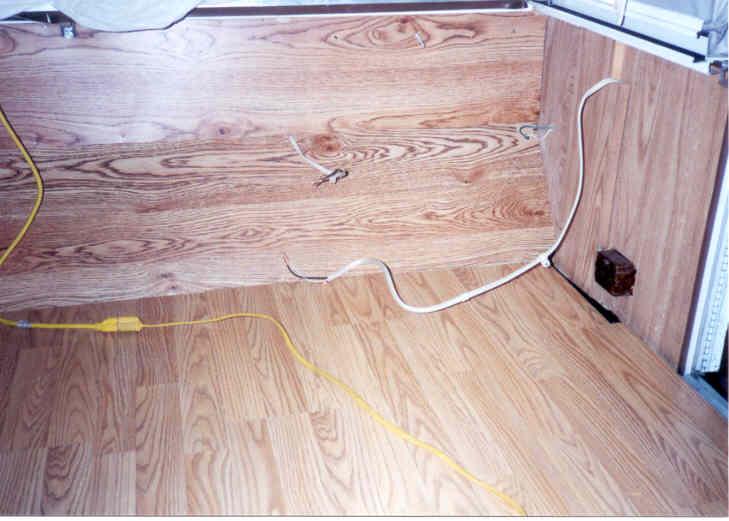
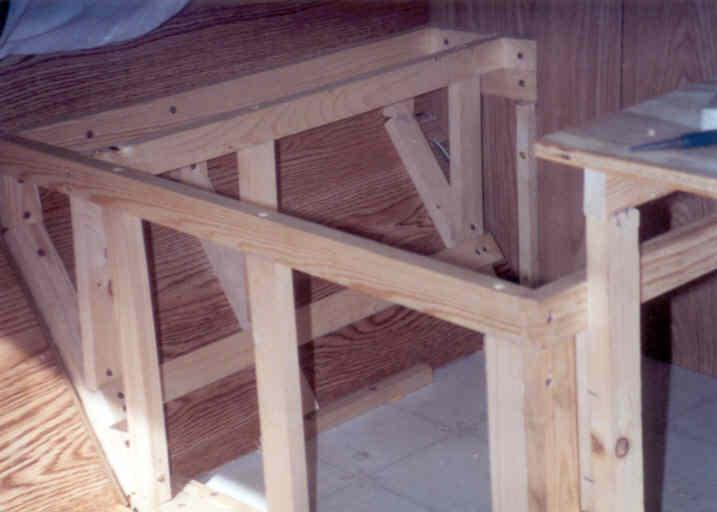
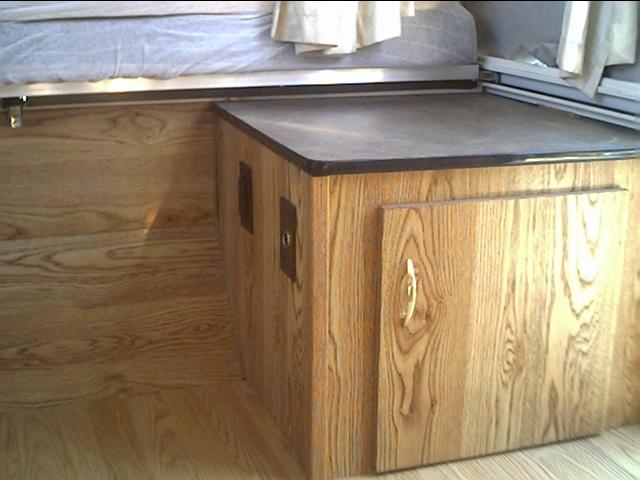
Once our final plans were completed we bought all the components before starting work. We also needed hardware, hoses, trim, flooring, paneling for walls and cabinets, wood for frames, fabric, a sheet of Formica, foam pads for the beds, and a bunch of other stuff.
To be honest, it would have almost been cheaper to buy a new camper of the same size, but we couldn’t have gotten everything we put in ours. We camped several hundred nights over the next couple of years and towed it several thousand miles. It was almost perfect.
If you would like to take a Tour of our Meteorite and read the details about the upgrades and modifications click here.
Almost Perfect
The living space was somewhat sparse, but we spend most of our time outdoors when camping. Two things became somewhat problematic. First the refrigerator was much too small for trips of a week or more. And we still didn’t have enough storage for all our stuff. We were still packing and unpacking our SUV for each trip, albeit much, much less than before the rebuild.
So we went shopping for our 2nd camper <sigh>
We settled on a 2006 Fleetwood Niagara.
2006 Fleetwood Niagara and the 3 Things We Wanted
1. More Storage & Living Space

This camper was 14 feet long vs. 8 feet for the old camper. It had a dinette that slid out, so we more than doubled our living space and most of that living space could be used for storage when traveling.
2. Residential Height Counter Tops
Most tent trailers have short side walls, which means sinks and stoves have to be on hinges and folded over or placed on the floor so the roof can be lowered. This really reduces storage space. The Niagara had much higher walls, meaning nothing had to take up additional storage space when traveling.
3. A much larger refrigerator
Since the counters were higher than our Starcraft, the fridge was much larger because it can be tall, not to mention wider.
Other considerations
The Niagara had everything we needed that was installed in our Meteorite rebuild with some caveats.
- Solar would have to be added. We did this before we took it out for the first trip.
- We wanted two batteries, so we just used the ones from the other camper.
- It came with one propane tank, so we installed two 10 gallon tanks.
- It came with a furnace, so we purchased a larger Wave 8 heater, to use in conjunction with the furnace.
- We knew we probably wouldn’t like the awning, and only used it once. It was replaced.
The Niagara even had a microwave that we never used and a nice oven that was nice to use occasionally.
The Day from Hell
Eight years after we bought the Niagara, which was just about perfect except for some tweaks here and there and a problem with the axle, disaster struck. The camper was vandalized and totaled by our insurance company.
When we starting exploring our options to replace the camper, Fleetwood had sold its tent trailer division and the camper was no longer being made, plus I really didn’t relish doing all the work we had done to it over the years.
If you would like to take a Tour of our Niagara and read the details about the upgrades and modifications click here.
Joyce wanted a travel trailer. I had picked out the last two. Since we would soon be retiring she felt a larger trailer would better suit us as we planned on doing a lot of retirement camping. Plus she felt the set-up and take-down process for each campsite would become too much of a hassle as we got older. I was okay with a travel trailer as long as it had a BIG fresh water tank.
2014 Eclipse Milan 26RLS and the 1 Thing We Needed
1. A Large Fresh Water Tank
The trailer Joyce picked out had a 100 gallon water tank and two 50 gallon tanks for black and gray water. I had never seen tanks of this size on a trailer, so I was good to go with it, even though it was a little larger than what I felt we needed and we would need to buy a larger tow vehicle. But there was little debate. The First Law of Marriage prevailed:
Happy Wife = Happy Life
Travel trailers don’t come with solar systems, so we would need to install one and a couple of 6 volt golf cart batteries. I was actually looking forward to this because I had learned a lot about solar over the past 10 years and now I would be able to create and install the perfect solar system for our needs. We would also need to buy another Wave 8 heater. All this was done before our first trip. Other than these items, the trailer had everything we wanted based on our last two trailers.
If you would like to take a Tour of our Milan and read the details about the upgrades and modifications click here.
If you are considering the purchase of a camper hopefully I’ve provided some thoughts that can help you decide what you really need. To be honest, our trailers have met our needs and at the time of purchase were exactly what we needed. What changed was us. Our needs changed over time and each successive trailer met those needs.
